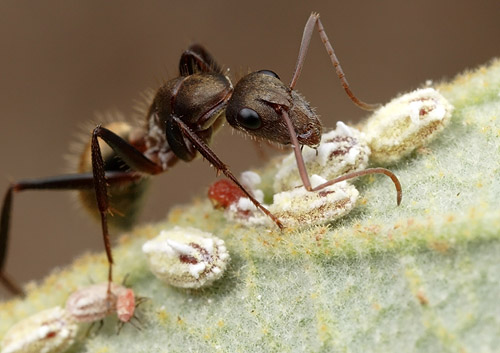Another piece of the Camponotus hyperdiversity puzzle was published this week in BMC Evolutionary Biology. The reasons behind the tremendous richness of Camponotine ants- a worldwide group of conspicuous insects containing more than a thousand species- are unknown, but recent explanations have focused on the nutritional relationship between the ants and their endosymbiotic Blochmannia bacteria. These gut-dwelling microbes may have allowed camponotines to capitalize on honeydew resources nutritionally unavailable to other ants, opening opportunities for evolutionary radiation.
In the latest paper, Jennifer Wernegreen isolated Blochmannia DNA sequences from a variety of ant species. Combining these with sequences previously known from other insects, the researchers reconstructed the evolutionary history of the symbionts. What did they find? From the abstract:
Phylogenetic analyses of 16S rDNA gave four important insights: (i) Blochmannia occurs in a broad range of Camponotini genera including Calomyrmex, Echinopla, and Opisthopsis, and did not occur in outgroups related to this tribe (e.g., Notostigma). This suggests that the mutualism originated in the ancestor of the tribe Camponotini. (ii) The known bacteriocyte-associated symbionts of ants, in Formica, Plagiolepis, and the Camponotini, arose independently. (iii) Blochmannia is nestled within a diverse clade of endosymbionts of sap-feeding hemipteran insects, such as mealybugs, aphids, and psyllids. In our analyses, a group of secondary symbionts of mealybugs are the closest relatives of Blochmannia. (iv) Blochmannia has cospeciated with its known hosts, although deep divergences at the genus level remain uncertain.
So ants picked up the bacteria from honeydew-producing insects that already carried them as symbionts.
Incidentally, interactions between microbes and social insects are becoming some of the hottest topics in entomology. This trend was apparent in the research talks at ESA this week, with many labs now exploring the relationship of ant societies and their bacteria. I expect to see plenty more studies in this vein in the coming years.
Source: Wernegreen, J. J. et al (2009)Â One nutritional symbiosis begat another: Phylogenetic evidence that the ant tribe Camponotini acquired Blochmannia by tending sap-feeding insects. BMC Evolutionary Biology 9:292. doi:10.1186/1471-2148-9-292


Yah know I wonder if this triggers queen ants to start laying again in the spring time. It would sure explain some of the conflicting issues I've noticed with hibernating colonies.